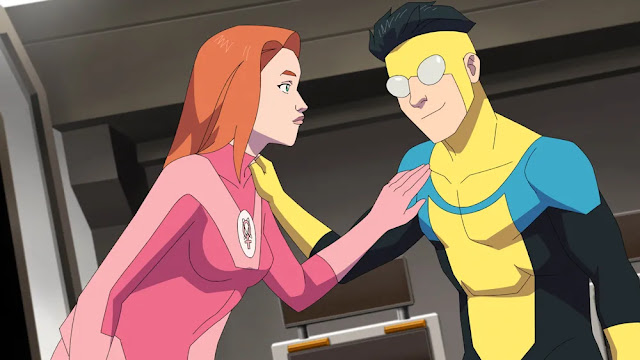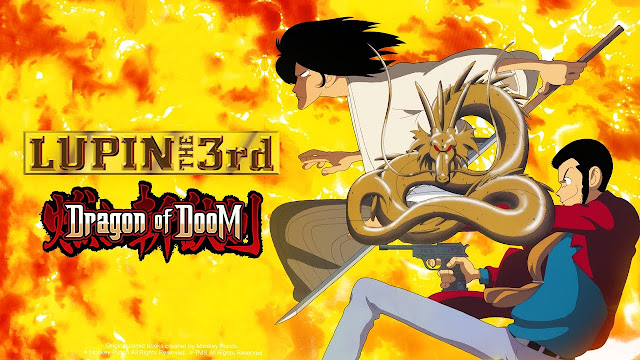PHENOMENALITY: *marvelous*
MYTHICITY: *fair*
FRYEAN MYTHOS: *comedy*
CAMPBELLIAN FUNCTION: *psychological*
How different would the film world have been, had producer Charles Band, instead of producing dozens and dozens of schlocky horror/SF movies, had instead kept making schlocky softcore sex movies like FAIRY TALES and its 1977 predecessor CINDERELLA? Well the film world probably would have not have been very different, but Band probably would have lost his shirt and taken up some less stressful occupation, like tax preparation.
That said, I still enjoyed the amiable stupidity of TALES years after having seen it once years ago (unlike its companion piece CINDERELLA, which I've yet to lay eyes upon). Despite a fair amount of nudity, TALES barely sets forth any erotic scenarios; even a musical number involving BDSM falls flat as the protagonist's, er, little problem. TALES' entire repertoire is just a lot of sniggering sex jokes. not unlike Jack H. Harris' MOTHER GOOSE A GO GO-- though even that one used its nursery rhyme characters to better psychological effect than TALES does.
As I mentioned before, the whole excuse for a story hinges on the fact that the unnamed Prince (Don Sparks) of an unnamed kingdom is about to turn 21 and inherit the throne. However, according to his advisors, including comedian "Professor" Irwin Corey, Prince cannot take up the mantle of kingship until he can prove he can get something else up, and thus prove his ability to sire offspring. In the version I saw-- a VHS rip on YouTube, with Italian subtitles-- there's no explanation as to why this supposed youth (who looks about forty) has been struck by impotence. But Prince happens to have a photograph of Sleeping Beauty (Linnea Quigley in one of her first roles), and he's confident that he can make babies with such a stone fox. So he girds his loins-- in this case, by belting on a sword-- and leaves his kingdom for the nearby terrain of Fairyland, where he has some reason to think he'll find Sleeping Beauty.
Fairyland in this case is more like one of the many "all-fairy-tales-sold-here" worlds, though Prince doesn't seem to recognize any of the figures he meets on his quest-- Little Bo Peep (Angela "LOST EMPIRE" Aames), Snow White and the Seven Dwarfs, Tommy Tucker, Scheherezade (Nai Bonet), Old King Cole, Peeping Tom, and the Frog Prince. The original version is also supposed to have some erotic schtick with Jack and Jill, but this didn't appear in the version I watched. IMDB lists actors who played the roles of "Little Red Riding Hood" and "The Little Dutch Boy," but I never spotted either one. There's one character in the mix who might be entirely original, a witch named "Aunt Le Voh," who's no fairytale creation, though her name resembles that of historical figure Marie Laveau, a 19th-century "free woman of color" and practitioner of voodoo. The role is played by singer Martha Reeves at a point when she sought (unsuccessfully) to branch out into acting. She later claimed that she didn't know she was filming an erotic movie, though in her one scene, she exchanged lines with another performer on the subject of curing Prince's impotence with her magic.
Her enchantment doesn't work, which isn't surprising since the movie sports very little any actual magic, which would have required money for effects and/or costumes. The one partial exception is the Frog Prince, but he didn't require a costume, being that the only froggy part of him is most often covered by his pantalones.
Aside from Prince having short and inconsequential encounters with Bo Peep and the Jack-and-Jill couple, almost all the action takes place within a colossal laced-up boot, "The Shoe of Pleasure," which is Fairyland's foremost whorehouse. The woman who lives in this shoe doesn't have any children; I guess she knew what to do. The writers give the Madame Who Lives in a Shoe (Brenda Fogarty) a name culled from a separate nonsense-poem, that of "Gussie Gander." Gussie's partner is a pimp named Sirus (pronounced "Cyrus"), who's fully conversant in seventies-style jive. As played by Sy Richardson, Sirus has some weird, hard-to-follow lines when he lures Prince to the Shoe of Ill Repute; one of his raps says something like "I'll show you what made Peter Pan fly, and how Olive Oyl popped eyes."
Once Prince makes it to the shoe, he makes a deal to give eighteen percent of his kingdom to Gussie and Sirus if they can help him solve his little problem. But nothing works, not even when Madame Gussie breaks her own rule against sleeping with customers and tries to seduce Prince. However, by some coincidence Gussie just happens to have a special treasure she hasn't shared with any other customer: a virgin who seems to be sleeping all the time. So Prince thinks his problem's solved, but oh, no, in addition to being asleep she's really ugly, so they cover her up again. Then some other customers hear about the virgin, and they all want her, sight unseen, which leads not to any good slapstick but just some lame running-about. While being chased by Gussie, Prince trips and falls upon the covered-up face of Ugly Sleeping Beauty. Apparently Prince accidentally presses his lips to his/her/its face, for when the cover is removed-- hey, it's Linnea Quigley at last! So it's a happy ending, except that the film has Tommy Tucker bore the audience with a goofy summing-up spiel.
Barely any jokes really land; most just do a big belly-flop. But I still mildly like TALES, though probably only for assembling talents who all did better work elsewhere: Fogarty, Aames, Reeves, Angelo Rossito, and Frank Ray Perilli (one of the writers, best known as "Penn" of INVASION OF THE STAR CREATURES). The one exception is that I'd never noticed Richardson in anything I'd seen before, and he's quite good, even though he reunited with Nai Bonet the next year in an even worse movie, NOCTURNA. Since Perilli and the other two writers were all Americans, I don't know how much credit to give them for the possible coincidence that some Brits use "goose" as a word for "prostitute," or even for the possible "Laveau" pun. Certainly both bits of wordplay would have gone over the heads of the audience, as opposed to all the dopey sex jokes.



















